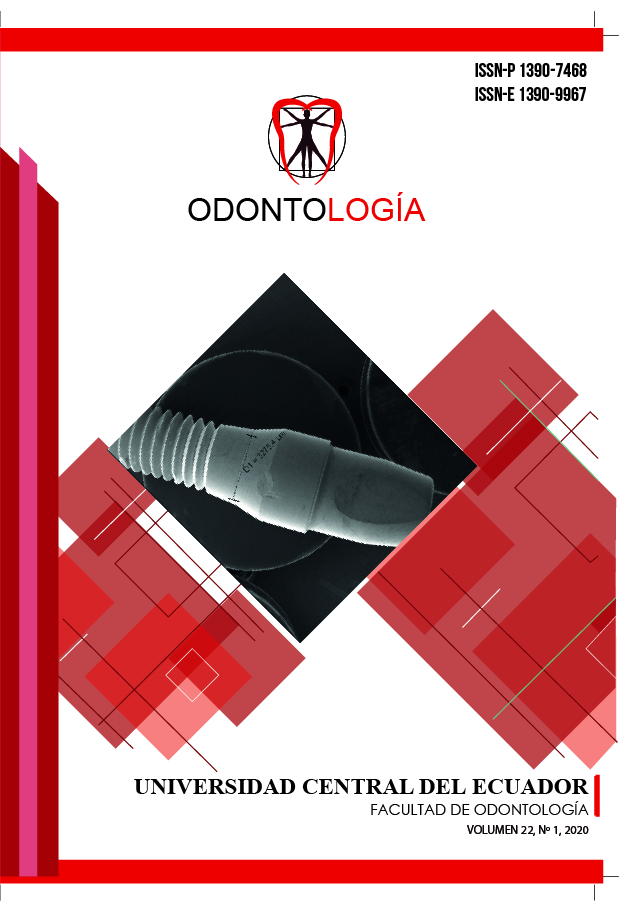Adult patient treatment with previous open bite by atypical deglution. Case report
DOI:
https://doi.org/10.29166/odontologia.vol22.n1.2020-82-92Keywords:
Open bite, malocclusion, swallowing, adult, case managementAbstract
The previous open bite is a malocclusion in which one or more teeth do not get the occlusal plane and no contact is made with their antagonists. Its treatment is difficult and there is controversy in the need for a surgical approach. The present case relates to the management of a 61-year-old female patient, treated at the clinic of the Mexican Institute of Orthodontics, who came for "separation of her teeth." The clinical and radiographic evaluation presented a skeletal class I, biprotrusive, with overbite of -30% with low and non-consonant smile, atypical swallowing as an etiological factor that allowed the diagnosis of anterior open bite. The treatment consisted of the placement of Roth slot .022 prescription brackets with tubes up to upper and lower third molars, placing more gingival braces with respect to the center of the anatomical crown of both arches to achieve extrusion and closure of the open bite and arch of smile; in centrals at 1.5mm, laterals at 1mm and canines at 0.5mm. The use of posterior occlusal bumpers and also of short and light anterior elastics from the first day of treatment was essential. Correction of the position of the teeth was achieved in a period of 18 months, which also induced a change in the swallowing pattern. Through the proposed treatment plan it was shown that occlusion stability can be given and that not every patient with an open bite is a candidate for surgical treatment for the correction of this malocclusion.
Downloads
References
Proffit W, Fields H, Sarver D. Ortodoncia Contemporánea 5ta. Edición, España, Elsevier. 2014.
Moreno Sinovas E, Halabi Díaz T, Alió Sanz JJ. Tratamiento temprano vs tratamiento tardío. ¿Cuándo actuar? Parte I. Clase II y Mordida Abierta. Ortodoncia Clínica. 2009; 12(1):21-33.
Oliveira AC, Almeida Pordeush I, Silva Torres C, Torres M. Feeding and nonnutritive sucking habits and prevalence of open bite and crossbite in children/adolescent with Down Syndrome. Angle Ortthodontist. 2010;80(4): 748-52
Ramírez Mendoza J, Bulnes López RM, Guzmán León R, Torres López JE, Priego Álvarez HR. Características y alteraciones de la oclusión en la dentición primaria en preescolares de 3 a 6 años en Tabasco, México. Odontol Pediatr. 2011; 10(1): 6-12.
Thilander B, Peña L y colaboradores. Prevalence of malocclusion and orthodontic treatment need in children and adolescents in Bogotá, Colombia. An epidemiological study related to different stages of dental development. European J of Orthod. 2011; 23: 153-67.
Cozza P, Baccetti T, Franchi L, Toffol L, McNamara JJr. Mandibular Changes produced by Functional appliances in Class II Malocclusion: A sistematic Review. AJO. 2008; (5): 8.
Thilander B, Peña L y colaboradores. Prevalence of malocclusion and orthodontic treatment need in children and adolescents in Bogotá, Colombia. An epidemiological study related to different stages of dental development. European J of Orthod. 2011; 23: 153-67.
Proffit WR, Fields HN, Maray LL. Prevalence of malocclusion and orthodontic treatment need in the United States: estimates from the NHAMES III Survey. Int J Osthognath Surg. 2003; 13 (2):97-106.
Cangialosi TJ. Skeletal morphologic features of anterior open bite. Am J Orthod. 2008; 5:28-36.
Proffit WR. The timing of early treatment: an overview. Am J Orthod Dentofac Orthop. 2001; 129(4):47-9.
Ngan P, Fields HW. Open bite: a review of etiology and management. PediatrDent. 1997 Mar-Apr;19(2):91-8.
Cozza P, Baccetti T, Franchi L, Mucedero M, Polimeni A. Sucking habits and facial hyperdivergency as risk factors for anterior open bite in the mixed dentition. Am J Orthod Dentofacial Orthop. 2005 Oct;128(4):517-9.
Xin N, Tao W, Ashwin D, Jinlin S. Establishment of integral biomechanical
Zhou Y, Li Z, Wang X, Zou B, Zhou Y. Progressive changes in patients with skeletal Class III malocclusion treated by 2-jaw surgery with minimal and conventional presurgical orthodontics: a comparative study. Am J Orthod Dentofacial Orthop. 2016 Feb;149(2):244-52.
Tavares CAE, Allgayer S, Calvete ED, Polido WD. Orthodontic treatment for a patient with advanced periodontal disease: 11-year follow-up. Am J Orthod Dentofacial Orthop. 2013 Sept;144(3):455-65.
Ataç M, Asvaroğlu K, Yücel E. Prospective evaluation of quality of life in orthognathic surgery patients. Int J Oral Maxillofac Surg. 2015;44(1 Suppl 1):e31.
Marwat HJ, Amin B, Khan A. Frequency of anterior open bite patients reporting to AFID, RAWALPINDI. Pakistan Oral & Dental Journal. 2009; 281(1): 71-4.
Bennet Greg and col Efficacy of Open-Bite Treatment with the Thera-spoon. JCO 1999 33:5, 283-285.
Garrett J, Araujo E, Baker C. Open-bite treatment with vertical control and tongue reeducation. Am J Orthod Dentofacial Orthop. 2016 Feb;149(2):269-76.
Shapiro Peter. Stability of open bite treatment. Am J Orthod Dentofacial Orthop 2002;121:566-8.
Alexander Charles Open bite, dental alveolar protrusion, Class I malocclusion: A successful treatment result Am J Orthod Dentofacial Orthop 1999;116:494-500
Lopez-Gavito G, Wallen TR, Little RM, Joondeph DR. Anterior open bite malocclusions: a longitudinal 10-year postretention evaluation of orthodontically treated patients. Am J Orthod 1985;87:175-86.
Published
How to Cite
Issue
Section
License
Copyright (c) 2020 Rafael González Padilla, Cristina Sánchez Escobar, José David Ortiz Sánchez

This work is licensed under a Creative Commons Attribution-NonCommercial-NoDerivatives 4.0 International License.


